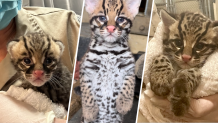The Los Angeles Zoo has shared photos and video of its new adorable ocelot kitten achieving cuteness goals.
In video and photos released Monday, the kitten is seen wrapped in a towel, standing on his hind legs, playing with crinkled paper and pouncing on pumpkins.
Kitten life.
The kitten was born Sept. 12 and will remain behind the scenes at the zoo until he is ready to move into an outdoor habitat.
Get Southern California news, weather forecasts and entertainment stories to your inbox. Sign up for NBC LA newsletters.

Weighing just 19 ounces at birth, the unnamed young ocelot now weighs 6 1/2 pounds. There are good health signs all around for the kitten, who will eventually grow larger than the average house cat, but not quite as large as a bobcat.
"His eyes opened after nine days and his teeth began to erupt after 20 days," said Los Angeles Zoo animal keeper Stephanie Zielinski. "At first, he was toddling around on unsteady legs, but he’s become stronger and more agile every day. He has a big personality now, and he's brave and curious."
Local
Get Los Angeles's latest local news on crime, entertainment, weather, schools, COVID, cost of living and more. Here's your go-to source for today's LA news.
Ocelots spends their days in trees and brush, then hunt at night with help from their night vision and sensitive whiskers.
Guests will eventually be able to visit the kitten and mom Maya at the zoo.
The kitten is part of a pairing recommendation form the Ocelot Species Survival Plan. The breeding program between accredited zoos is designed to maintain genetic diversity.
Ocelots are classified as Least Concern by the International Union for Conservation of Nature, but the U.S. Department of Fish and Wildlife lists them as endangered. The population has drastically decreased due to habitat loss and human activities, including illegal hunting, the zoo said.



